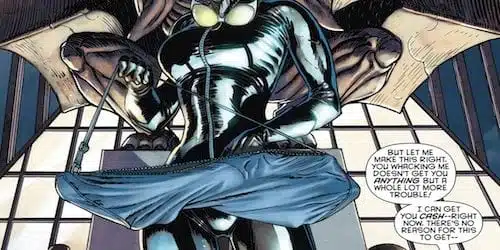
It’s a singular moment in DC’s New 52. It’s the moment of sharpest, clearest characterization. And if there were any justice in the world, you’d pay double the cover price for Catwoman #3. Triple the price. But you’d get the book for just three bucks, US.
Writer Judd Winick’s perfected a strange, easy magic with Catwoman. Easy because it reads like almost every comicbook you and I and everyone we know has grown accustomed to reading. It’s a flawlessly superhero mainstream book. It’s what inspires that really groovy girl you met on the bus into San Diego to dress in that leather catsuit and goggles.
And strange.
Strange because the places Judd Winick has taken the core cast of Catwoman has been unimaginable until Winick actually did it. We’ve seen Winick paint an immensely human portrait of the reckless brio that is Selina Kyle, plan for a retirement. Not so much by gathering up material things, but a retirement that can see her shed her “wild child” nature. This is the drama of the deepest kind of Counter-Insurgency — a COIN of the soul. We’ve seen her in the midst of a sexual relationship with the Batman, a man who never reveals his identity to her. We’ve seen her live through the destruction of her apartment, and now the murder of her friend.
“No One Can Find Any Piece of Me Here”, the most recent issue of Catwoman, picks up immediately where the previous issue left off. Selina Kyle’s Catwoman has just returned to the home of Lola MacIntire, her fence. She’s expecting her payday from the job she pulled earlier in Issue #2, but just as she steps into Lola’s, everything goes crazy-bad-wrong.
Lola’s been murdered, tracked down by the erstwhile owner of the truckload of stuff that Selina stole. Selina herself, overwhelmed by grief, finds herself quickly dispatched by the henchmen of one Lewis “Bone” Ferryman. The issue opens with Selina already bound to a chair, already beaten down by Bone’s dial-a-thug stooges.
The narrative arc itself is pretty standard fair. Selina breaks free, tracks Bone down, beats him to within an inch of his life, then the Batman appears as a cipher of final authority. Selina yields, but not without tossing Bone off the roof leaving it to Batman to leap to save him.
But the easily-recognizable plot only strengthens your focus on what really matters–the characterization. Selina’s anger is more than palpable, it is your own. “You killed her over stuff”, Selina cries against a blood-sprayed background. Behind the blood-rage you can hear the tears welling up.
And then the Batman. He shows up just in time for the customary superhero rescue. The rescue not of the sickeningly violent Bone, but of Selina herself. He’s there in her moment of greatest need, at the very second before she crosses the line. And she doesn’t. But course she doesn’t make it easy for him. Doesn’t simply conform to his expectations of being “the good girl”. She still gets in the last word, kicking Bone off the roof, knowing the Batman will catch him in time.
You look at Batman in that moment and you realize what the romantic dynamic has really been about all this time. Batman loves Catwoman, Batman and Catwoman up on a roof. This isn’t a Batman playfully seduced by his own wild side projected lucklessly onto a nearby girl-thief. This is something much deeper. This is about the need to rescue, time and again, the one person who hasn’t yet completely succumb to her limitations. A daring that places you in danger. Selina Kyle is simply the perfect love note to human ambition in an age of climate change.
You look at Selina and then you look at your lover. And you wish for just a second… But then you begin to realize, there beneath the everyday of the shower left messy and the burnt toast and crazy, frenetic rush of tax season, your girlfriend, your wife is still every bit Selina Kyle. Or maybe you go home and see that beneath the beer and behind the farting and underpinning the well-intentioned but totally misaligned iKea, your husband, your lover is every bit Batman. There to rescue you at the moment of your greatest danger.
Winick succeeds by simply surpassing the expectations of these characters. There’s no way not to evoke the immense operatic drama of the first meeting between Julius Caesar and Cleopatra. At a time when she was about to murdered by her Pharaoh-brother Ptolemy XIII, she escaped her prison by being rolled into a carpet to be presented to Caesar. The same themes of sex and wealth and danger and rescue run through Caesar and Cleopatra’s first meeting as run through Catwoman #3.
So the real achievement here, is not Winick’s magnificent explanation of the Batman-Catwoman love affair by using Batman as the supporting character. It is how easily Catwoman #3 prepares us for Roman history, for classical opera, for the full scope of so-called “high” culture.
If there were any justice in the world, if creators were paid by the effect that have on the world, Catwoman #3 would cost you $9.00. Or double that, or even triple that. But there’s every chance for you to express your appreciation. Buy an extra copy, buy two. Leave them in places people can find them. Donate them to libraries. Circulate them through the world. Because somehow, some way the beauty of these ideas need enter into the world. Maybe they enter the world because of you.
